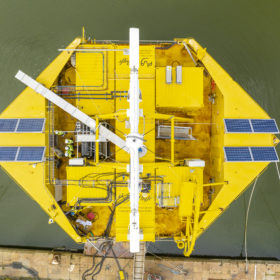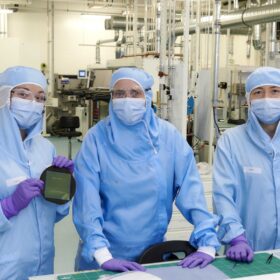Italian energy supplier to reuse discarded PV modules for social projects
Italian energy producer ERG has launched an initiative to reuse discarded solar modules from revamped plants for social solar projects. The program aims to support communities, hospitals, families, and schools in Africa and Italy, using panels that are still in good condition and fully functional.
EU-funded project seeks set up pilot production of large-area perovskite PV modules
The EU-funded Laperitivo project aims for 22% efficiency in 900 cm² opaque perovskite modules and 20% efficiency in semi-transparent ones. The project partners include imec, Fraunhofer ISE, TotalEnergies, and EDF.
Agrivoltaics postpone harvest, improve wine quality
Italian winemaker Svolta Srl has deployed an agrivoltaic facility at its vineyard in Apulia, Italy. The PV array allowed the cultivation of vines that are normally not viable at this latitude.
The Hydrogen Stream: Hydrogen storage in lakes, reservoirs
King Abdullah University of Science and Technology researchers have told pv magazine that hydrogen storage pipelines and gravel could become a reality in lakes or water reservoirs in Europe, the United States, Japan, or China within 10 years. “The technology required to implement the proposed system is available, simple and cheap,” they said.
Italian startup develops thermo-mechanical PV panel recycling process
Venice-based 9-tech has developed a thermomechanical process to recycle end-of-life PV panels, with early results showing an 87% recovery yield of materials such as silicon, copper, and silver.
Italy’s first agrivoltaic tenders draws bids for 1.7 GW
Italy’s Ministry of the Environment and Energy Security (MASE) says it has received 643 bids totaling 1.7 GW in its first agrivoltaic tender. About 56% of the proposals have come from the country’s sunny southern regions.
The Hydrogen Stream: Hamburg to install 100 MW electrolyzer system
The Hamburg Green Hydrogen Hub has tapped Siemens Energy to provide and install six electrolyzers for a 100 MW system, with construction set to begin next year and commercial operation expected by 2027.
The Hydrogen Stream: H2Mare project links electrolyzers to wind turbine
The German government says that the H2Mare OffgridWind project in Denmark has connected two electrolyzers to a wind turbine for hydrogen production, while Ontras Gastransport and H2 Energy Europe have agreed to define the technical and commercial framework for hydrogen transportation in its Green Octopus Mitteldeutschland pipeline project.
Italy added 25% more energy storage systems in Q2
Trade body Italia Solare has processed data from electricity transmission system operator (TSO) Terna which shows standalone storage is the biggest new market development.
CEA-INES, Enel achieve 29.8% efficiency for tandem perovskite-silicon solar cell
The 9 cm² cell consists of a top cell based on a perovskite absorber and a bottom cell with a heterojunction (HJT) structure. The results improve on the 28.4% efficiency CEA and Enel achieved for the same kind of cell in December.










